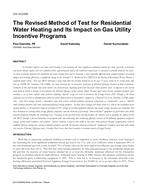Description
As envelopes improve over time, water heating is fast becoming the most significant residential natural gas load, especially in moderate and warm climate regions such as California where approximately half of all residential natural gas is consumed to provide domestic hot water. To more accurately represent the residential hot water heating load and to encourage a more equitable differentiation amongst products of varying designs and resulting efficiencies, a significant change to the existing U.S. Method of Test (MOT) for the Rating of Residential Water Heaters is currently under review. This new MOT represents a large shift from the existing method in use for over 15 years, which in its current form, like that of ASHRAE Standard 118.2-2006, has been criticized for its unrealistic portrayal of delivered efficiency observed in field evaluations. Elements of this shift include how water heaters are characterized, beginning with what hot water draw patterns used. Compared to the current draw pattern, which is known to overestimate the delivered efficiency of low volume, higher thermal input water heaters (tankless products most notably), a set of more realistic draw patterns reflecting "typical" usage are used to determine the Energy Factor (EF) through a 24 Hour simulated use test with an appropriately scaled hot water draw pattern to the product’s category, as a Point-of-Use, Low, Medium, or High output unit. Also these changes include a broadened scope with several excluded products previously categorized as "commercial", such as "hybrid" tank/tankless products and some condensing-efficiency storage products. In total, these changes will likely result in a shift in the residential water heating market, as the potential range of variations of EF ratings of existing equipment impacts how energy savings measures are estimated, thus their treatment in existing utility energy-efficiency programs, and the inclusion of previously "non-residential" equipment in government and utility incentive programs broadens the technology base. Focusing on the gas-fired water heating market, the authors seek to quantify the impact of this new MOT through a focused laboratory test program with non-condensing and condensing efficiency versions of the following equipment categories: storage, hybrid tank/tankless, and tankless. Special attention is paid to how shifts in hot water draw patterns through categorization result in modified efficiency ratings for existing residential products and with the broader inclusion of formerly "commercial" products rated only with steady state metrics (Thermal Efficiency and a Standby Heat Loss), how these translate to transient metrics (Energy Factor).
Citation: ASHRAE Papers: 2015 ASHRAE Annual Conference, Chicago, IL
Product Details
- Published:
- 2015
- Number of Pages:
- 8
- File Size:
- 1 file , 1.7 MB
- Product Code(s):
- D-CH-15-C045




